RVAR 2010 exemption: London Underground Limited Bakerloo line trains
Published 29 February 2024
This application is structured into a background and one topic section, which covers the light rail vehicle – Bakerloo line 1972 Tube stock – for which an exemption is sought.
Full name of the applicant
Richard Jones, Director of Asset Performance Delivery
Address of the applicant
London Underground Limited
5 Endeavour Square
London E20 1JN
Background
The Bakerloo line serves 25 stations, 15 of which are underground, over 23.2 kilometres (km). It interchanges with other services at:
- London Paddington
- Marylebone
- Waterloo
- Oxford Circus
- Baker Street
Exemption orders made to date
To date, one RVAR exemption order has been made, as shown in the published list-of-rvar-exemption-orders. It is 2019 Order, for 1972 Tube stock, (PDF).
Section 1: light rail vehicles
Description of the rail vehicles to which the application relates
Table 1: Bakerloo line 1972 Tube stock – vehicle numbers
Class number: 1972 Tube stock (class 499/2)
Manufacturer: Metro-Cammell, Birmingham, United Kingdom
| Car | Car numbers | Total |
|---|---|---|
| Driving motor (DM) | 3231 to 3248, 3250 to 3256, 3258 to 3267 and 3299, 3331 to 3348, 3350 to 3356, 3358 to 3367, 3531 to 3538, 3540 to 3567 | 107 |
| Trailer (T) | 4231 to 4248, 4250 to 4256, 4258 to 4267 and 4299, 4331 to 4348, 4350 to 4356, 4358 to 4367 and 4399, 4531 to 4538, 4540 to 4567 | 108 |
| Non driving motor (NDM) | 3431 to 3438, 3440 to 3467 and 3399 | 37 |
| Total | 252 |
Table 2: fleet formation
Fleet formation is: 36 by 4-car units and 36 by 3-car units, when each coupled together forms a 7-car train.
| Formation | Fleet type |
|---|---|
| 36 by 4 car units | DM to T, T and DM |
| 36 by 3 car units | NDM to T, T and DM |
The 1972 rail vehicles currently operate on the Bakerloo line that runs from Harrow and Wealdstone in north-west London to Elephant and Castle in south London.
Services provided
Normal services are provided at these times.
| Time of the week | First or last train | Harrow and Wealdstone to Elephant and Castle | Elephant and Castle to Harrow and Wealdstone |
|---|---|---|---|
| Weekday | First train | 05:39 | 05:37 |
| Weekday | Last train | 23:54 | 23:47 |
| Weekend | First train | 07:19 | 07:16 |
| Weekend | Last train | 23:12 | 23:26 |
The exemption provisions of RVAR
Schedule 1, part 1 (general requirements)
8(2) Subject to sub-paragraphs (3) and (5), the floor of a vestibule to a passenger doorway in the side of a rail vehicle must contrast with the adjoining floor of the passenger saloon of the vehicle.
8(6) At a passenger doorway in the side of a rail vehicle the floor must have a band of single colour running parallel with the full width of the entrance:
-
not less than 50 millimetres (mm) and not more than 100mm wide
-
the edge of which furthest from the entrance must not be more than 100mm from the edge of the floor at the entrance
-
which contrasts with the adjoining floor surface
10(1) Subject to sub-paragraphs (2) and (3), a handrail must be fitted in the following positions:
- in every rail vehicle, on the inside as close as practicable to, and on either side of, the passenger doorways in the side of the vehicle, extending vertically from a point not more than 700mm above the floor to a point not less than 1,200mm above the floor
10 (4) Subject to sub-paragraphs (5) and (6), any passenger handrail fitted in or to a rail vehicle must comply with the following requirements:
- it must have a circular cross-section with a diameter of not less than 30mm and not more than 40mm
11(1) The interior of a rail vehicle must be fitted with a public address system for audible and visual announcements.
11(5) While a rail vehicle is stationary at a station or stop any public address systems required to be fitted inside the vehicle, and on its exterior, must be used to announce the destination of the vehicle or, if it is following a circular route, the name or number of the route and, in the case of systems inside the vehicle only, to announce the next stop.
18(4) Where a train consists of the number of rail vehicles shown in a row of column A of the following table that train must have at least the number of wheelchair spaces shown in column B of the table set out below.
Noting the conditions previously as set out article 3(d) and 3(e) of the previous 2019 Exemption Order:
-
3(d) exemption from paragraph 10(1)a only applies provided that where the doorway has a single door
-
3(e) exemption from paragraph 10(4)a only applies provided that the handrail has a circular cross-section with a diameter of not less than 28.40mm and not more than 40mm
In addition, London Underground is seeking derogation against Paragraph 6(5)(a) in Schedule 1, part 1 (general requirements).
6(5) the route between a wheelchair-compatible doorway and a wheelchair space must:
-
not have a step, or a slope with a gradient exceeding as measured when the vehicle is on a straight and level track:
-
5%
-
provided the slope does not exceed 2,000mm in length or 8%
-
Engineering assessments concluded that it is technically challenging and risky to reconstruct the underframe structure to comply with the above requirements.
Technical, economic and operational reasons for the application
Being the oldest rolling stock in the UK currently in active passenger service, it is already a challenge to make modifications to the coach-built vehicles operated, which began operation in 1972. The programme to modify the Bakerloo line rail vehicles (72TS) continues despite the COVID-19 pandemic and the current financial challenges that Transport for London (TfL) faces. Planned rolling stock overhauls also faced the same challenges to maintain asset condition.
The upgrade programme commenced works in 2018 to 2019, at which point completion in 2023 to 2024 was anticipated. Progress was delayed by the pandemic, supply chain issues and technical problems.
Funding uncertainty continues: if this were not a barrier to delivery, the entry into service of the first fully RVAR-compliant train would be early summer 2024, with the programme expected to complete by 2029. Exemption of the features included in the upgrade is, therefore, needed until 2029 and exemption for non-compliant features is needed indefinitely for the life of the vehicle. A replacement plan, and timescale, for a new-build (compliant) fleet is anticipated but not yet defined, and subject to funding uncertainty.
All these have prolonged the programme of RVAR modifications required on the Bakerloo line fleet to meet the RVAR compliance at the exemption expiry date for the following clauses:
-
8(2) subject to sub-paragraphs (3) and (5), the floor of a vestibule to a passenger doorway in the side of a rail vehicle must contrast with the adjoining floor of the passenger saloon of the vehicle
-
8(6) at a passenger doorway in the side of a rail vehicle the floor must have a band of single colour running parallel with the full width of the entrance:
-
not less than 50mm and not more than 100mm wide
-
the edge of which furthest from the entrance must not be more than 100mm from the edge of the floor at the entrance
-
which contrasts with the adjoining floor surface
-
18(4) Where a train consists of the number of rail vehicles shown in a row of column A of the following table that train must have at least the number of wheelchair spaces shown in column B of the table below.
The prolongation was also in part due to the technical complexities involved in integrating a modern passenger information system (PIS) (audio and visual) with the existing electrical configuration in the 72TS to meet the clause:
- 11(1) the interior of a rail vehicle must be fitted with a public address system for audible and visual announcements
This new system (prototype) has been installed on a train, which is being tested and refined to improve the sound quality so that it meets London Underground’s technical requirement.
Paragraph 10 (1) a: handrails in doorways
Additionally, London Underground is requesting that partial compliance is accepted for handrails in single doorways on the 72TS as it has been proven through implementation it is impossible to comply in all areas. Below details the output from current works.
Providing handrails on both sides of the single doorways on the 72TS has proven technically unfeasible. There is no stand-back area (as indicated in figure 1) in the single doorways at the end of each car meaning that any handrail would protrude into the door opening if fitted to the body end side. This is because the doorway is very close to the end of the car.
Original equipment and wiring still remain behind interior panels at the car ends, therefore, to implement this change TfL would need to relocate these behind the interior panels at each car end which would pose technical challenges.
Figure 1 shows the area that would be required to be removed from the body panel to fit a handrail, which would still protrude into the doorway and the structure behind the panelling.
Figure 1: single doorway area

It is possible to retrofit a single compliant vertical handrail in the single doorways on the saloon side. The locations, which will have handrails fitted once refurbishment is complete, are indicated in figure 2.
Figure 2: handrail positions post refurbishment
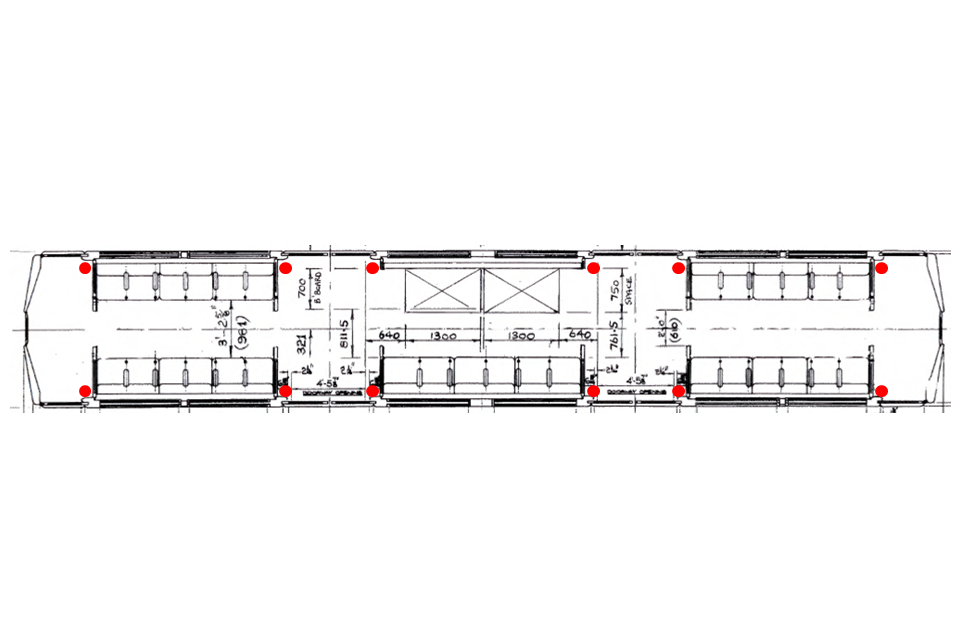
While it may be possible to fit handrails to the body end, this would require 10 unique designs to ensure that equipment was not disturbed behind the panel.
Additionally, wiring and structural support for the equipment have been seen to vary in location between differing cars of the same design. This further adds to complications and may lead to a modified design for each individual installation. The different car ends are detailed in figure 3, which shows the complications with working in this area of the train and the number of built configurations.
London Underground has considered that there is minimal disbenefit as the provision of one handrail at these doorways will provide significant improvement to accessibility at these doorways today. It also results in a similar situation to double doorways, where it is unlikely somebody would be able to use both handrails to board or alight.
A secondary concern is the inability to fit a handrail in the uncoupling non-driving motor (UNDM) car units where the shunting control panel is fitted. This area is highlighted in red in figure 3. Relocating this equipment would be complex and would likely affect the functionality of the panel, which is used for moving units around depots. It is, therefore, considered unfeasible to fit any extra structures in this area.
Rather than fit handrails in all positions other than UNDMs, a consistent approach to all single doorways would give the best value for money and benefit customers. Having a single handrail in all end car doorways will ensure that there is no expectation of anything different when boarding or alighting the train. At double doorways, the 72TS will have a compliant handrail on each side of the doors.
Figure 3: car body ends (excerpts from LU drawings 77767, 77768, 77769 and 77770)
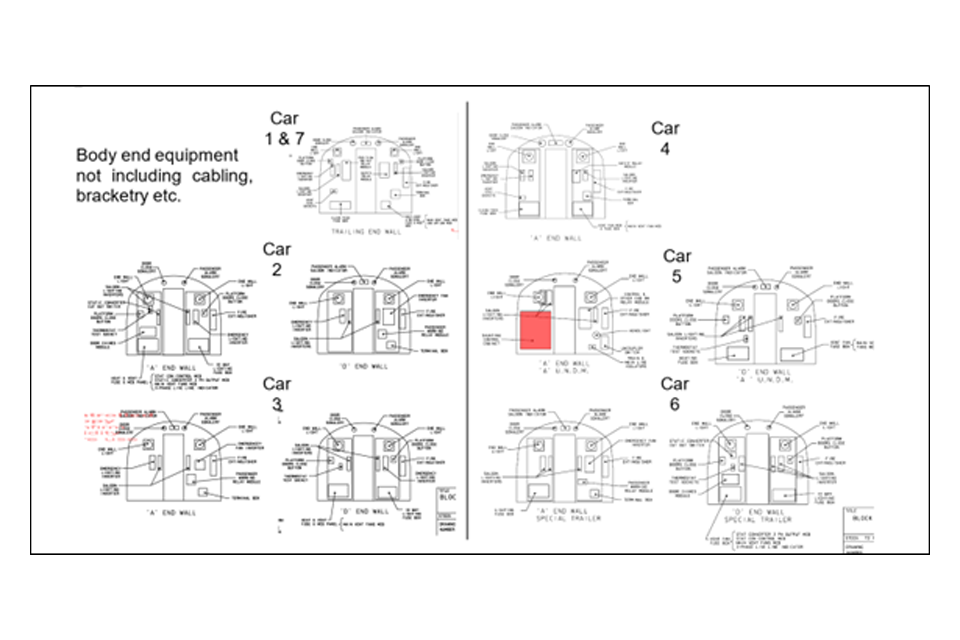
Paragraph 10 (4) a: handrail circular cross-section
London Underground is requesting derogation against paragraph 10(4)a, as it is not believed to be economic to replace the horizontal handrails on the 72TS.
The train has not undergone an interior refurbishment with RVAR upgrade since it was brought into service and as such has many of the original fixtures. The horizontal handrails are 28.49mm to 29.55mm (nominal tubing diameter of 28.54mm plus coating as shown in figure 4) in diameter and as such fall short of the 30mm stipulated by RVAR.
London Underground does not believe there would be an economic case to replace all the horizontal handrails on the fleet for an average increase of 1mm in diameter. It is perceived that the very small difference between regulated and the provided handrails is unnoticeable.
Figure 4: horizontal handrails (LU drawing 75166)
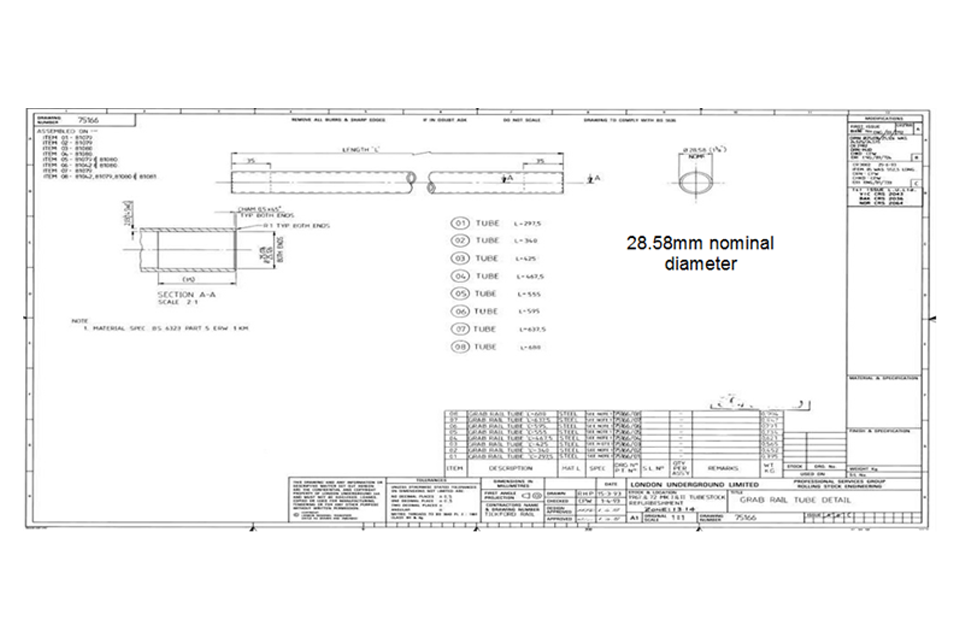
Paragraph 11(5)
London Underground is seeking an exemption that would allow the public address system to announce the name of the next stop whilst the vehicle is travelling towards that direction. It is believed that announcing the ‘destination’ information provides the same benefit to passengers while at a station. This is because the direction of travel can be ascertained from the destination, as routes are simple and maps are available inside the train. Additionally, the ‘next station’ and ‘destination’ announcements are made during the interstation run.
There is a concern that the operation of the passenger service could be impeded in delivering all regulated information while stationary at a station. The dwell time is carefully balanced with run times to operate the train service and delays while stationary can have knock-on impacts to service robustness and over-crowding.
London Underground strongly believes that better service to passengers can be provided by reducing the amount of regulated information given. This allows a driver to give additional information about service disruption, interchange with other transport modes or London Underground lines, step-free access and where appropriate high-level local and tourist information. All regulated information will still be given inside the train between stations in audible and visual format once the new passenger information system is delivered as part of the train overhaul.
Passengers on the platform are informed from a range of sources including:
- audible station announcements
- platform ‘next train’ display indicators
- visual displays on the external side of the vehicle
- fixed signage, such as network maps
Supplementing this are platform ‘help points’ that enable passengers to communicate directly with station staff for further information.
The Bakerloo line operates a high-frequency service and London Underground believe that the information provided is representative of the ‘spirit of RVAR’ in its meaning: namely the direction of the train and destination where it is appropriate to give this information. Short run-times between stations offer reassurance if a passenger is travelling in the wrong direction and frequent service allows for correction quickly and easily with the minimum disruption should this occur.
In applying for this exemption, London Underground will bring the Bakerloo line fleet into line with the services used on the network. The standardisation of messaging brings consistency across the London Underground and aids travellers with familiarity of the service. In silent time, during the dwell, the driver or digitised announcer system can make announcements, where applicable, without detracting from the purpose of the regulated information.
Paragraph 6(5)
The modification to the 72TS provides 2 new RVAR-compliant wheelchair spaces. Existing equipment, previously under the seats, has to be relocated and reconfigured into a bodyside cupboard to fit in the wheelchair spaces.
The floor of the 72TS is level throughout the saloon and the centre of the vestibule with a 6.3% slope towards the bodyside doors. The partition by the wheelchair space side of the bodyside door has been reduced in depth to allow access from the wheelchair space to the vestibule.
Figure 5: partition by the bodyside door (highlighted by the red circle)

To make the transition from the level floor of the wheelchair space to the sloping floor of the vestibule a sloping triangular section of flooring is required. This section has a continuous slope of 12%, although it varies in length due to the triangular shape of the section.
Figure 6: triangular section of flooring by slope
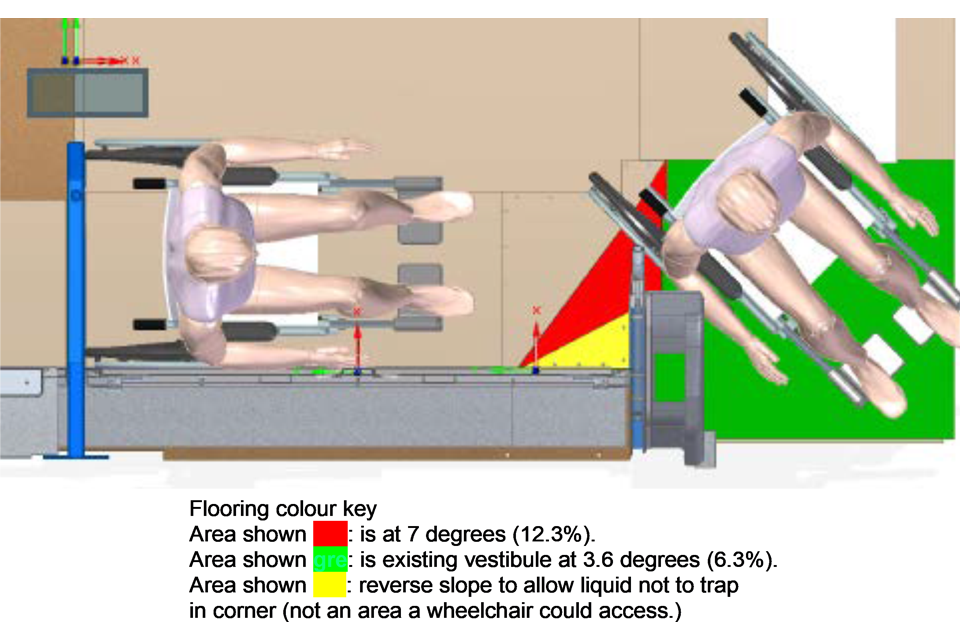
The slope is a result of allowing sufficient width to manoeuvre a wheelchair, but this exposes the chassis rail which limits the smoothing of the gradient further. Reducing the angle would also take the slope into the vestibule floor breaking into the continuous slope to the doorway and creating a trip hazard for all passengers.
Effect of non-compliance on a disabled person’s ability to use the rail vehicles
London Underground does not believe that an extension of the current exemptions will cause any greater detriment to the ability of disabled persons to use the train. Customer experience and fleet operations staff have been briefed on the introduction of trains with partial modifications (without PIS) to fully compliant RVAR trains (with PIS).
Bulletins distributed to the staff outlined the actions they would need to take when helping passengers use the Bakerloo line at each station. Every modified RVAR train that enters service is an improvement to an existing non-modified 72TS. Active engagement has also been had with our TfL diversity and inclusion team on the Bakerloo line modifications progress so that it can be communicated to our user groups at their discretion.
Works undertaken (new single door handrail in figure 7) are deemed to be technically compliant for the safety of our customers. It is impossible to fit a handrail on the side of the door closest to the vehicle’s body ends without significant costs and work done to modify and relocate the structural supports and equipment housed in that area. Where a passenger is unable to use the single handrail, due to a weakness on one side or similar, then the adjacent door on the next vehicle, where the handrail is on the opposite side, can be used instead.
Figure 7: single door handrail
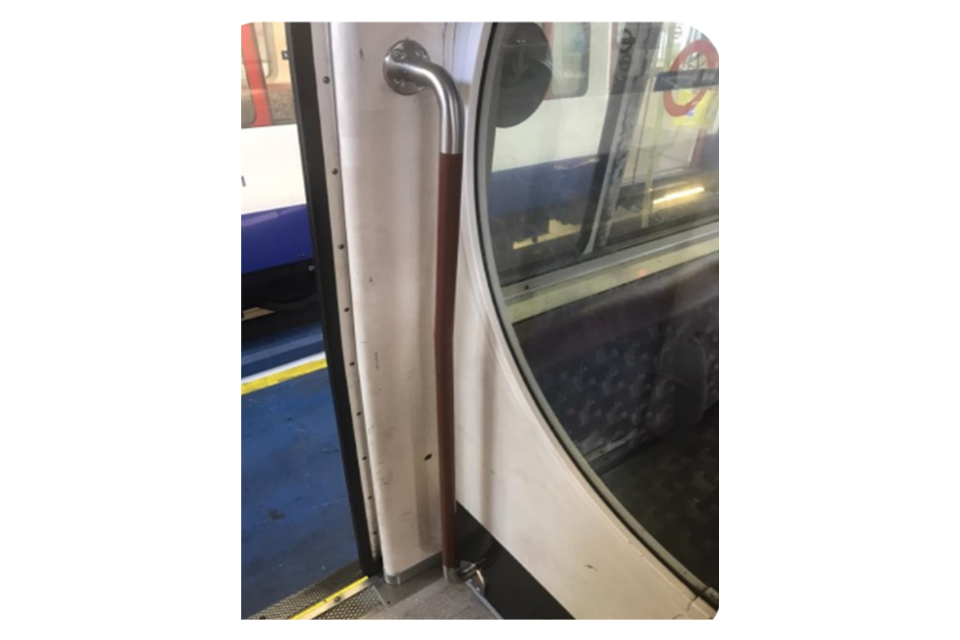
The existing horizontal handrails in the passenger saloon have a diameter of 29mm. It was agreed in 2019 with DfT and the Disabled Persons Transport Advisory Committee (DPTAC) that the costs of replacing these handrails by under 1mm were excessive compared to the minor improvement in accessibility it would deliver.
Existing vehicles do not have visual displays now but works are in progress to fit a new passenger information system (PIS) on each vehicle (figure 8). No ‘final destination’ announcement will be made while the vehicle is stationary – this would be made in between stations – to allow audio announcements of the next station and major accessibility or interchange reminders in the vehicle within the station dwell time. This is in line with those on the Victoria and Northern lines.
Figure 8: passenger information system
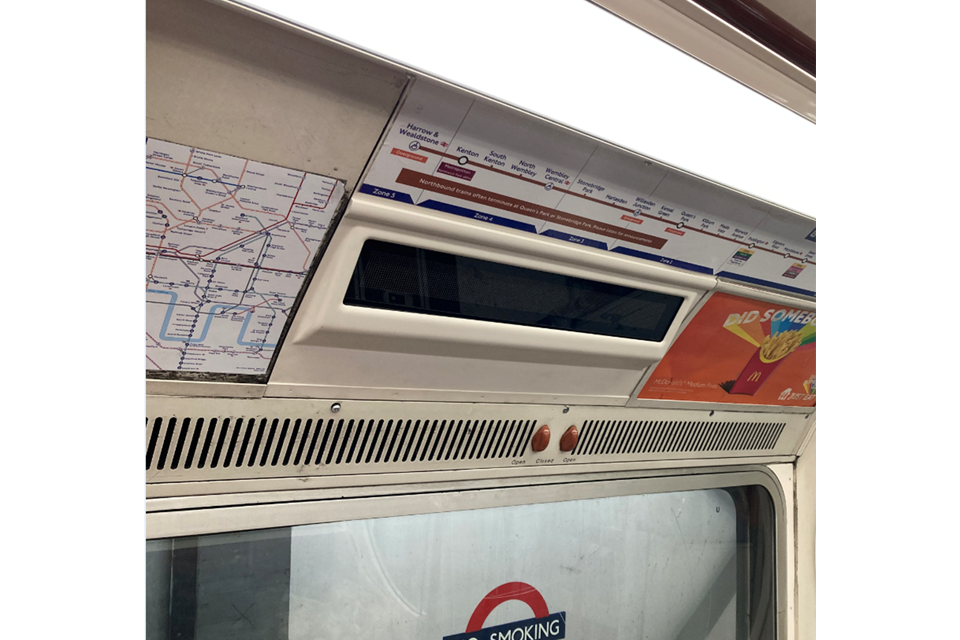
With regards to the floor slope, London Underground does not believe that this would have any significant effect on a wheelchair user using the 72TS. The 12.3% (maximum) slope is localised in the transition from the vestibule to on wheelchair space. While the slope is greater than the 8% permitted by paragraph 6(5)a of Schedule 1 RVAR, the slope is over a 170mm distance so very little momentum would be gained when moving down this slope compared to a longer slope.
Figure 9: flooring between the wheelchair bay and stand-back areas
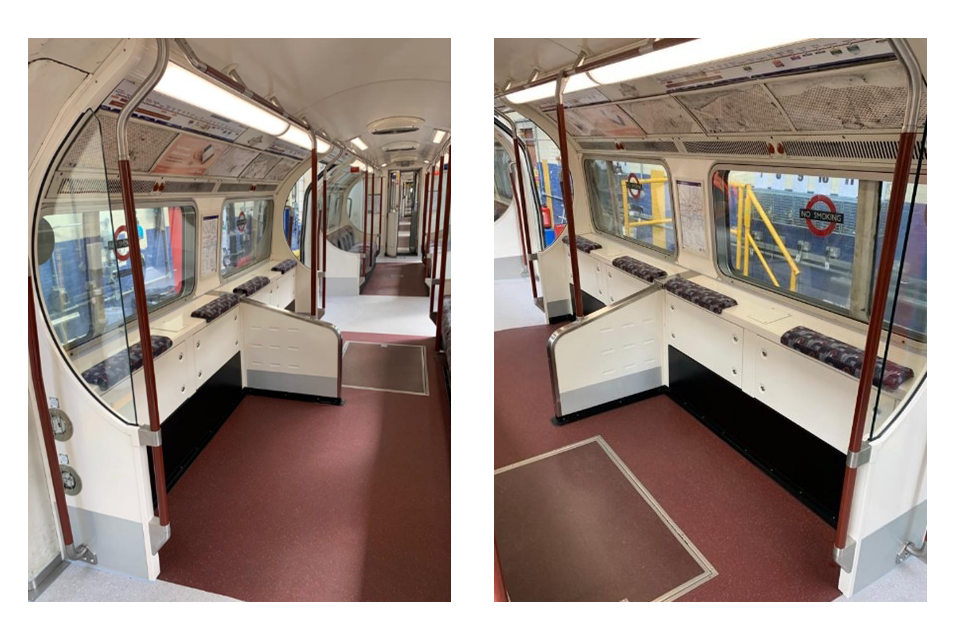
The area between the wheelchair position and the stand-back contains the flooring used to make the transition between the saloon level floor and the slope of the vestibule to the bodyside door (figure 9). This is outside of the manoeuvring space for the wheelchair user, typically located in the area of the footrests rather than the wheels. As the route to the small area is supported by the handrail, the resultant gradient is considered low risk for ambulant and visually impaired users with a walking device.
Measures proposed, if the application is granted, to enable a disabled person to use the rail vehicle
London Underground has made progress converting the 72TS saloon lighting to LED to provide better lighting levels: and at the same time to power the PIS. By the end of 2025, testing of PIS will be complete, and one car in each train throughout the fleet will also be fitted with wheelchair spaces, accompanying contrasting flooring and new doorway handrails. An extension of the current exemptions will allow London Underground to continue the modifications to meet the RVAR requirements.
London Underground does not believe that there are any technical solutions which can be taken to address the non-compliant gradient of the slope that are economical and provide value. Any proposal will be constrained by the underframe equipment and clearance from the tracks. For assurance purposes, London Underground will monitor incidents (slips and falls arising from the slope) for 12 months starting from the last modified train to confirm that there is no requirement to mitigate any risks arising from the non-compliant slope.
London Underground has also sought to minimise the effect of these exemptions on disabled people’s ability to travel. By using a combination of platform ‘humps’ and MBRs a person with restricted mobility will be able to access parts of the Bakerloo line that would otherwise have no provision for wheelchair users to embark or disembark from train to platform. It is impractical to make all stations step-free on the line due to the constraints. Therefore, trained staff will be deployed to use a ramp at some stations.
Assistance however is available on a ‘turn up and go’ basis meaning that delays to a journey are minimised as much as practical and do not need to be planned in advance. However, at selected stations included in the ATP, advanced booking is required. The selected stations on the Bakerloo line include:
- Harlesden
- Harrow Wealdstone
- Kensal Green
- Kenton
- Queen’s Park
- South Kenton
- Stonebridge Park
Exemption order request: timeframe
There are currently no proposals for later modifications of these rail vehicles. It is intended that the vehicles will be subject to an exemption order until their end of life.
Full RVAR compliance on the Bakerloo line, subject to the above requested exemptions, is dependent on the successful commissioning of the first prototype PIS train. The passenger emergency alarm, to convert a multifunctioning area into a compliant wheelchair bay, relies on the passenger information system. This prototype train will be introduced into service in mid-2024 and, progressively, more RVAR-compliant trains will be made operational on the Bakerloo line until all works are complete in late 2028 and handover to service in 2029.
London Underground seeks the following:
-
an extension of exemptions set out at articles 3(b) to (c), 3(f) and 3(h) of the Rail Vehicle Accessibility (Non-Interoperable Rail System) (London Underground Bakerloo line 72 Tube Stock) Exemption Order 2019 until 31 December 2029
-
permanent exemptions from regulations 6(5), 10(1)(a), 10(4)(a) and 11(5) of RVAR up to the life of the vehicle due to the issues with compliance as set out earlier
Prior consultation with vehicle operator
London Underground is the owner and operator of the rail vehicles. Therefore, there are no consultation responses to report.
How to respond
If you have any comments or feedback you would like to provide regarding this consultation, you will find contact details under our ways to respond section.
The consultation period began on 29 February 2024 and will run until 11:59pm on 28 March 2024. Please ensure that your response reaches us before the closing date.
